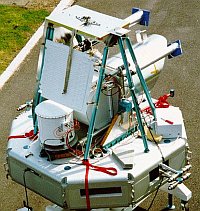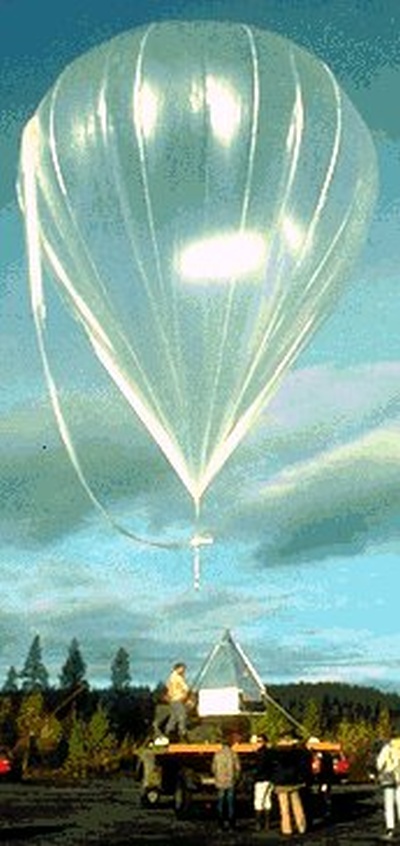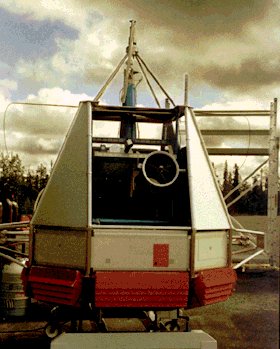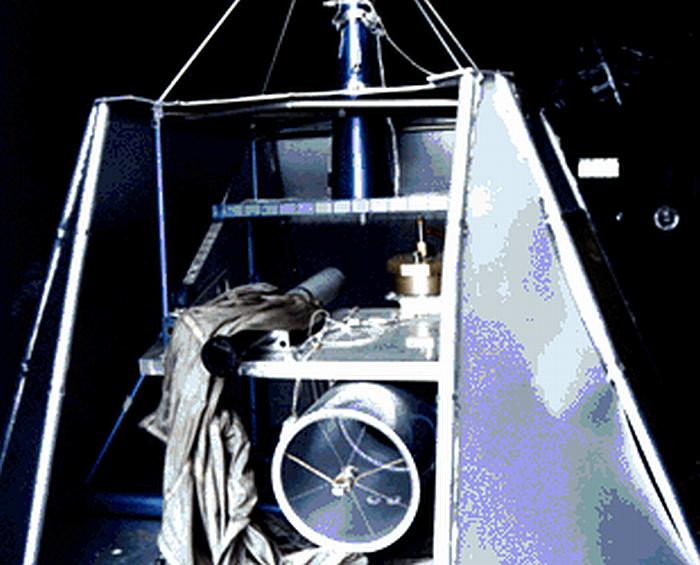Purpose of the flight and payload description
In 1983 a group of scientists proposed to the Swedish National Space Board the construction of a general purpose stabilized balloon platform capable of carrying a 200 kg payload for stratospheric flights lasting up to 12 hours. It was built by the Swedish Space Corporation and was used to perform astronomical observations of the interstellar medium in the far infrared spectral range in eight missions spanning the 15 years of duration of the project.
The platform base -see image at left- on which instruments and telescope were mounted was octagonal shaped. The entire gondola had a width of 3 meters and a height of 2.9 meters, weighting less than 500 kg. It's mechanical design was planned keeping in mind that it would be used repeated times in several flights so was developed to avoid damage to vital parts of the instruments at landing. Thus, the central telescope mount was located inside a lifting yoke which was in turn surrounded by an impact protection cage. Crush pads mounted below the gondola were also included in each flight to absorb the landing shock.
The azimuthal stabilisation was achieved by means of a cold gas system that used compressed nitrogen carried in pressurised tanks located below the gondola. During the flight, the gas passed through a buffer tank at an intermediate pressure whose flow was controlled very precisely by four proportional valves and let out through pairs of nozzles. There were two separate systems, the first one with high power thrusters for coarse control and the second one with low power thrusters for fine pointing.
During the observational phase of the flight, the proportional valves received signals from an analogue control system which used the sun as a reference. This system was composed by position sensitive photodetectors and a projected light spot. There was a coarse sensor, which used a slit for projection, and a fine sensor, which used a lens. In addition there was an independent, redundant sensor. Since sun sensors of this type worked best as nulling instruments, the angle to the sun was established by measuring the rotation of the platform on which they were mounted.
To facilitate the orientation of the telescope two TV cameras were used, along with two inclinometers that provided the information on the vertical attitude of the gondola. At any time of the flight two balance weights could be ordered to move along a pair of perpendicular rails in order to restore balance.
The PIROG gondola got their power from lithium battery packs with a total capacity of 300 Ah. The gondola itself consumed approximatelly 150 watts leaving more than 300 watts to the experiments for a 10 hour flight. The electronics inside the gondola were contained in four racks with their own power supply.
Scientific and housekeeping data was collected by a Pulse Code Modulation (PCM) system in both analogue and digital form and converted to a bi-phase format before being sent to the ground by a P-band transmitter. Telemetry data was sent with a speed of 256 Kbits/s throught near 800 channels with a sampling rate of 20 Hz, and with a resolution 16 bits. The telecommand system received commands sent from the ground station and interfaced them to the control system. Finally the signals from the two TV cameras were sent one at a time to the ground by a S-band transmitter.
For all these communication systems there were an onboard backup unit or some kind of redundancy.
During his useful life, the platform was progresivelly improved. The initial model (MK I) carried a 30 cm telescope coupled with a cooled Fabry-Perot spectrometer, a second generation of the instrument (MK II) incorporated a 60 cm telescope with a heterodyne receiver, and the final incarnation of the platform used the same telescope along with a SIS receiver. Several other improvements were made specially on the onboard electronics.
Nowadays, the gondola is diplayed at a museum located in the European Space Range, near Kiruna.
Details of the balloon flight
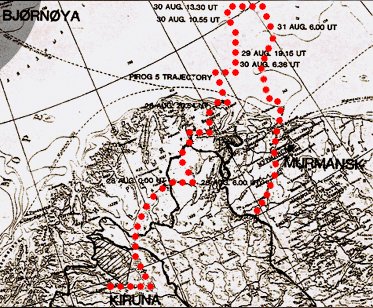
Balloon launched on: 8/27/1990 at 2:43
Launch site: European Space Range, Kiruna, Sweden
Balloon launched by: Swedish Space Corporation (SSC)
Balloon manufacturer/size/composition: Zero Pressure Balloon
End of flight (L for landing time, W for last contact, otherwise termination time): 8/27/1990
Landing site: Shootdown by soviet fighters near the Finish-Russian border.
After a failure and a landing in a swamp, in the previous mission, the gondola was refurbished and ready for flight three months later. It was launched as PIROG 5 -the sixth mission of the program- from the European Space Range (ESRANGE) near Kiruna, Sweden. This time the launch and flight was nominal but when the cut down command was sent to separate the payload from the balloon, nothing happened. The backup system, also failed leting the scientists nothing else to do than to helplessly watch the balloon drift slowly North-east out over the Arctic Ocean. After a few days it turned to South-east and drifted over the Murmansk area in Russia. It continued to drift south for a few days and then disappeared somewhere in the western part of Russia. The soviets who were tracking the overflight of the runaway balloon in their radars, probably remembered the US efforts to spy Russia using balloons in late 50's, and took the balloon as a reconnaissance device. Thus they dispatched two Sukhoi fighters to intercept and shootdown the visitor. Incredibly, the gondola landed rather undamaged in a wooden area near the finish border. Several months after the incident, following some diplomatic negotiations it was eventually returned to SSC.
However, the scientific outcome of the flight was significant as the prolonged flight offered the scientist the possibility to obtain data of their astronomical targets twice the time originally planned.
External references
- List of balloons launched from ESRANGE SSC Space website (via Archive.Org)
- The PIROG Program 13th ESA Symposium on European Rocket and Balloon Programmes. p.57
- The PIROG scientific balloon program at SSC website (no longer available) via Archive.Org
- UFO over Murmansk CIA reading room
1154If you consider this website interesting or useful, you can help me to keep it up and running with a small donation to cover the operational costs. Just the equivalent of the price of a cup of coffee helps a lot.

